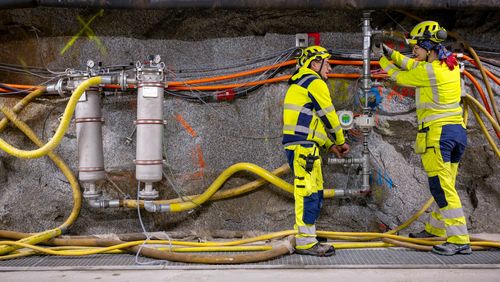
Mountain acts as giant sensor
The Bedretto Underground Lab is attracting interest from all corners of the globe. To ensure that even more experiments on deep geothermal energy can be conducted in the unique facility, construction work to enlarge the lab is scheduled for the winter of 2021, thanks to funding from the Werner Siemens Foundation. An additional kilometre of the former ventilation arm in the Furka tunnel—part of the Matterhorn-Gotthard railway line—is being restored and a second cavern converted into an underground lab. At the same time, the team are conducting tests to guarantee the safety of geothermal energy.
Taking a tour of the Bedretto Underground Lab is somewhat akin to embarking on time travel. Starting at the tunnel entrance in the Swiss village of Ronco, a path of some two kilometres leads through the interior of Piz Rotondo in the Saint-Gotthard Massif and on to the one-hundred-metre-long cavern, where researchers have set up the underground lab. “It’s a walk through Alpine history,” says project leader Domenico Giardini, professor of seismology and geodynamics at the Swiss Federal Institute of Technology Zurich (ETH Zurich). “Evolutionary developments that took place over hundreds of millions of years are visible here.”
Soon, the walk through granite and gneiss will be even longer, as a second lab is scheduled to begin operations in April 2022. The new facility will be located five hundred metres further into the interior of the mountain, where there is a cavern system with a total length of over eighty metres and a diameter of six metres—ideal conditions for a second underground lab.
A second underground lab
Thanks to funding from the Werner Siemens Foundation and in agreement with the tunnel owner, the extension can now be realised. Over the distance of another kilometre, the path through the tunnel is being paved, the ceilings reinforced, and each and every weak spot stabilised. In addition, workers are installing network cables, electric cables and water pipes as well as systems for ventilation, monitoring and security. Construction began in the winter of 2021 and is due to be completed roughly six months later. “The extension means we’re doubling our research capacity,” says project leader Domenico Giardini. “We’re buying time and rock volume.”
Giardini explains that converting the second cavern into a lab became a desideratum already early on. “But we didn’t think we’d be needing more space so soon.” Global interest in the Alpine lab is what has pushed it beyond its current capacity. For instance, the EU’s European Research Council is participating in research in the Bedretto Underground Lab with the largest ERC grant ever awarded to an earth science project. In addition, numerous universities and industry partners have expressed an interest in collaborating. “We came to the conclusion that we either had to stop all new projects or construct the extension right away,” Giardini says.
Geothermal energy for the winter months
The increased interest in the lab built into the Swiss Alps is no great coincidence. After all, geothermal energy is believed to be an indispensable technology for achieving climate neutrality. Indeed, existing sustainable energy sources like water, solar, wind and hot thermal energy are unable to cover our energy demand in winter; to compensate, Switzerland’s federal energy strategy calculates that by the year 2050, roughly seven percent of Switzerland’s power supply will stem from geothermal energy.
In theory, tapping into the earth’s heat to generate power is fairly simple. First, two holes are drilled deep into the earth where the rock is hot—at a depth of five kilometres, temperatures range between 150 and 200 degrees Celsius. In a second step, water is pumped into the first borehole, where it begins seeping through fine cracks in the rock until it reaches the second borehole. On its way, the water gets so hot that it exits the hole in the form of steam. This steam is then channelled into a turbine and used to produce electricity.

Safe fissures
A major drawback, however, is that hard rock like granite is nearly impermeable by nature, which is why geologists provide some outside assistance: they apply high pressure to the rock—in technical jargon, the rock layers are “stimulated”—causing fissures to form. This procedure requires painstaking care, as it can otherwise trigger major, and consequently devastating, earthquakes. This was the reason that Switzerland’s best-known geothermal energy project to date, which began not quite fifteen years ago in Basel, had to be abandoned.
Now the researchers in the Bedretto Underground Lab are seeking less invasive ways to generate fissures in the granite. They have already tested one promising method in the “Destress” project concluded in 2021: in a series of steps, staggered over time and in contained areas of the mountain, the team stimulated the deep rock layers to create controlled fissures. “It’s a major breakthrough for tapping into geothermal energy,” says Marian Hertrich, geophysicist at ETH Zurich and manager of the Bedretto Underground Lab.
Heat reservoirs to store warmth
The researchers are also testing an alternative method of energy storage: heat reservoirs. Rather than drilling down 5000 metres to produce electricity immediately, they want to determine whether a moderate depth of 1500 metres would be sufficient for heating the water during the summer months when electricity is available in great supply. During the cold winter months, power could then be generated from the heat stored in the reservoirs.
Heat reservoirs have two major advantages. First, dangerous earthquakes are much less likely to be triggered at more moderate depths. Second, costs are lower—partly due to savings on infrastructure expenses, but also because the electric power needed to pump the water through the rock layers is practically free in summer: already today, surplus energy is produced on peak days in summer, but a technology to store this power has not yet been developed. “In Germany, there are two to three days per month when electricity is sold at negative prices,” says Giardini.
New PhD programmes
Despite the many technological advances, not all aspects of heat storage have been fully explained. “When we pump large volumes of water into the rock layers, considerable stress changes occur. And the chemical balance is upset—all of which are complex processes,” Hertrich explains.
The researchers now want to study these “complex processes” in greater detail. To this end, several top European universities have joined forces in the new “International Training Network”, in which thirteen PhD students from ETH Zurich, TU Delft, RWTH Aachen and the Politecnico di Milano are conducting feasibility studies of the proposed heat storage method. The programme began in the autumn of 2021 and will last three to four years. “The focus is on the development and safe operation of geothermal water reservoirs,” says Hertrich. Some of the studies will be conducted in the Bedretto Underground Lab.
International collaboration
Numerous other research projects are also being conducted in the Bedretto Underground Lab—often in collaboration with industry partners. One such project uses a novel, high-resolution measurement instrument called the Step-Rate Injection Method for Fracture In-Situ Properties (SIMFIP). Installed inside the borehole itself, the aim is for the instrument to register changes in the rock even before the mountain is activated—a major innovation. “When the stress levels in the mountain are high, we have to proceed with a great deal of caution,” says Hertrich. “The new technology could prove extremely helpful in this area.”
The SIMFIP measurement instrument also offers a prime example of how important international collaboration is for research into future energy production: the instrument was developed by a US research institution and calibrated in Aachen, Germany, while a researcher at the University of Neuchâtel in Switzerland is responsible for interpreting the data.
World’s largest sensor
Across the globe, the Bedretto Underground Lab is one of a kind. With the high-resolution measurement system in operation since last summer, “part of the mountain has been converted into a giant sensor”, says project leader Giardini. Seven boreholes of depths up to three hundred metres were equipped with sensors and reinforced with cement to ensure the rock is, so to speak, unaware of the installation and that it reacts like intact granite. The team are now conducting experiments to stimulate the rock layers and cause fissures to form; a stimulation session is scheduled every one to two weeks. “That’s how long we need to evaluate and analyse the massive amounts of data delivered by the sensors in the boreholes,” says Hertrich.
Text: Andres Eberhard
Photos: Felix Wey





